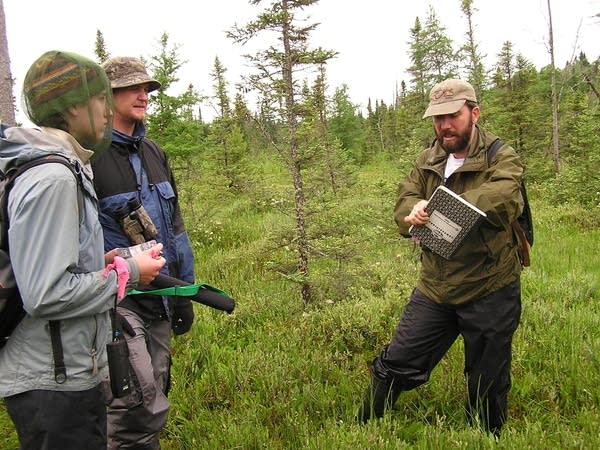Minnesota mounts ambitious five-year bird count

The atlas is an exceptionally thorough count of breeding birds. Over the next five years, volunteers will spend hours in a nine-square-mile section in each of Minnesota's 2,400 townships to record the birds they hear or see.

To count the birds in one of the most remote and inaccessible places in the state, three experienced researchers take a helicopter deep into the peatland in central Koochiching County.
The jumping off point is a tiny airport with a grass runway near Big Falls, about 20 miles from the Canadian border.
We fly for 15 minutes, over trees and swamps as far as the eye can see. We glimpse a moose, and a pair of trumpeter swans in their nest.
Create a More Connected Minnesota
MPR News is your trusted resource for the news you need. With your support, MPR News brings accessible, courageous journalism and authentic conversation to everyone - free of paywalls and barriers. Your gift makes a difference.
The helicopter hovers over an open area. The skids are six inches underwater. We're setting down in what's known as a floating bog.

We're wearing knee-high boots, rain jackets, and we sprayed all of our uncovered skin with DEET.
I'm following Heidi Seeland, a graduate student who seems to know her way around a bog.
The water is knee-deep, thigh-deep, and now it's waist-deep. I aim my boot at a clump of sphagnum moss. But it sinks under my weight, and sucks at my boot and I'm sitting in water.
Heidi helps me up, and we catch up with the others.

They fan out on different points of the compass. I follow ornithologist Matt Etterson. We walk for nearly half an hour. Etterson is aiming for a piece of higher ground, where the trees are a little taller, better for nesting.
Suddenly he stops, and sets his watch for 10 minutes and pulls out a notebook. It has a tally sheet with a bullseye printed on it.
Etterson cocks his head this way and that, jotting the names of the birds he can hear, and the time he hears them. He's the center of the bullseye, and the birds are all around, some close by; some farther away. He doesn't speak, and he doesn't pay any attention to the mosquito biting the back of his neck.
"We had a couple of hermit thrush -- that's the singing to the north of us. A veery called a couple of times to the west of us. A Nashville warbler, and a couple of western palm warblers, and that was about it. It was pretty quiet otherwise," Etterson said.

We trudge through the muck for another 20 or 30 minutes and he repeats the process.
It's two hours later, and the three researchers meet at the helicopter landing spot and compare notes. They're excited about Etterson's veery and Nashville warbler. The others heard a Connecticut warbler and a Lincoln's sparrow.
They would have been really happy if they'd heard a golden-winged warbler. It's one of the most threatened of bird species. The golden-winged warbler has declined by some 80 percent over the last 50 years.
Today's exercise is an experiment to see how well it works to count birds in remote parts of Minnesota using a helicopter.
[image]
Back at the Big Falls airport, Art Norton is waiting to hear the results of the count. He works with the Forest Legacy Partnership, a joint project of the Blandin Foundation, The Nature Conservancy, the Minnesota DNR, and several other groups, to keep forests from being divided up and developed.
We don't know much about the birds that use this peatland to raise their young, Norton says, partly because it's so remote. But it is a critical habitat for half of Minnesota's "species of greatest conservation need." That's 48 kinds of birds.
"Under current forest management, as far as we know they're still here," Norton said. "But it does mean that we need to pay a lot of attention to these forests and how they're managed, so we can continue to protect those species. And where species are in decline, how we might manage to improve their habitat."
Minnesota is behind most other states in creating a breeding bird atlas. Iowa did one 20 years ago, and birders there are working on an update.

It'll take five years to do the whole count for the Minnesota bird atlas. Organizers hope to recruit 2,000 or more volunteers. In the end, there will be a hard-bound book, and a Web site with maps and information about every bird species found in the state.
In 10 or 20 years, they'll do it all over again, to see how the birds are faring.
